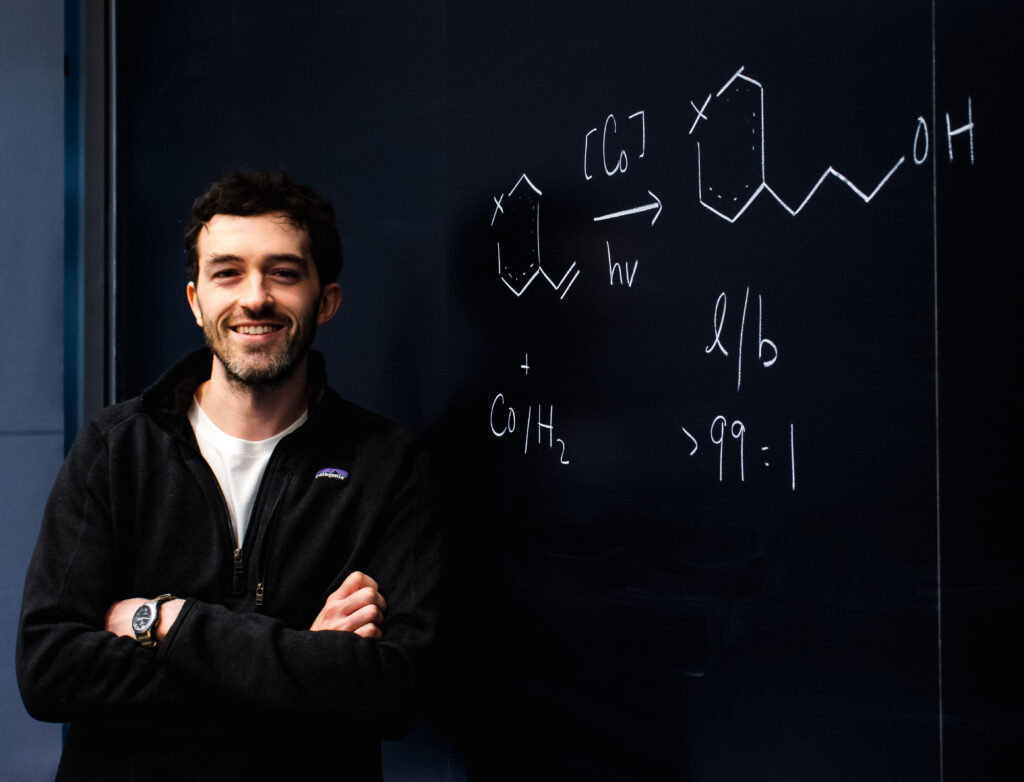Postdoc Q&A: The Chirik Lab’s Connor MacNeil

When Connor MacNeil first came to Princeton Chemistry in the fall of 2019 as a Visiting Student Research Collaborator (from the University of Lethbridge, Alberta, Canada), he worked with the Chirik Lab. Those four months with Chirik—“He is a P.I. I would have followed to Alaska”—were not enough for MacNeil, so he returned in the fall of 2020 to pursue postdoctoral work. Today, MacNeil looks forward to a new post in discovery process chemistry at Merck after a formative career at Princeton Chemistry. On the eve of his departure, here are MacNeil’s thoughts on the academic experience.
Your next step is with Merck?
Yes, I’m taking on a new role in the Discovery Process Chemistry (DPC) group at Merck, West Point, PA. The group operates at the interface of discovery chemistry, or medicinal chemistry and process chemistry. I’m working at an early point in the drug development pipeline and thinking about how to develop processes that can be scaled up for clinical studies.
Why does this work appeal to you?
I’m always trying to find the best chemistry for a given application. I was drawn to discovery process chemistry because I like working on challenging problems with a hard deadline. I think it’s naturally the most exciting place to be if you want to learn a lot of new chemistry, because new targets are constantly crossing your desk. Discovery chemistry is “everything everywhere all at once,” whereas process chemistry seeks to develop the best reaction. The intersection of those two worlds presents a formidable challenge: to develop the best chemical reaction in the shortest possible time .… I think that’s what drew me to it.
Do you see this as a continuum?
I think that’s exactly right. The training I received in Paul’s lab is directly translational. Approach a problem with clarity, find a way in, and try to develop the best chemistry possible. ‘Discovering’ new chemistry should go hand-in-hand with developing the best possible reaction. You can always make a reaction faster, more selective, while looking out for new and exciting transformations.
Did you like working in the Chirik Lab?
It was a challenging postdoc because of the pandemic, but my expectations were met and exceeded. All credit goes to the group for maintaining a culture of excellence while taking care to look after one another. What I appreciate about Paul is that he is uncompromising when it comes to delivering the best science. Despite all the challenges placed in front of us, he still had the highest expectations for the work. He was always pushing me to go for it.
How did you manage COVID lockdown and shift work?
My MO has always been to seek out collaboration. It’s no fun having individual success; it’s always better to share it. So, when the group was separated, you had to work to maintain connections with your lab mates on the morning or evening shifts. One of the most profound discoveries Will Whitehurst and I made was during this shiftwork. Together at the blackboard, 2 a.m., like something out of a movie. We were miserable, but that time brought us closer together as friends and led to the development of a new class of catalyst, and for Will, a new catalytic reaction. I wouldn’t do shiftwork again because I like my colleagues too much, but looking back I think it allowed me to spend the most time with the chemistry.
Your final paper was published in the fall?
Paul and I were interested in the interaction of visible light with stable organometallic complexes, specifically those containing iron and cobalt. I worked on cobalt-catalyzed reductive hydroformylation. Making alcohols from alkenes. We were interested in taking this reaction (hydroformylation) that’s more than 80 years old and applying it in a more modern context. We wanted to see if we could merge this organometallic photochemistry with this historically significant reaction, and it turns out that by shining visible light on these well-defined cobalt complexes you could not only do the reaction, but you could do it with perfect selectivity. It works and it works well.
Having worked under several P.I.s, what guidance can you provide about choosing a P.I.?
Having a P.I. who frames the problem from the outset is helpful. The strategy that Paul uses in the group is to apply well-defined organometallic chemistry to the most challenging problems in catalysis. You always feel like the stakes are high when the boss cares about the problems you’re working to solve. A good P.I. also realizes that each person has something to bring to the table. At the end of the day, there are humans at the bench doing the work, so a certain amount of empathy and understanding is needed. But at the same time, if you want to be successful, the boss has to want you to be successful. With that comes with a certain level of expectation that you have to be willing to meet.
What do you wish you had known before you started at Princeton Chemistry?
I wish I had trusted that my past experiences would help me in a pinch. It can be hard to see that at times, especially in a new place. You’re never really starting over; it’s never back to square one. By the time you’re finished grad school you have so much experience on which to draw from. You’re smarter than you think. I didn’t really take a break between finishing my Ph.D. and starting at Princeton so I wasn’t able to reflect on that. I wish I’d known that it would all turn out okay.
